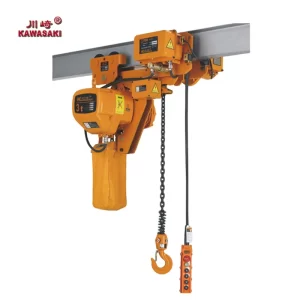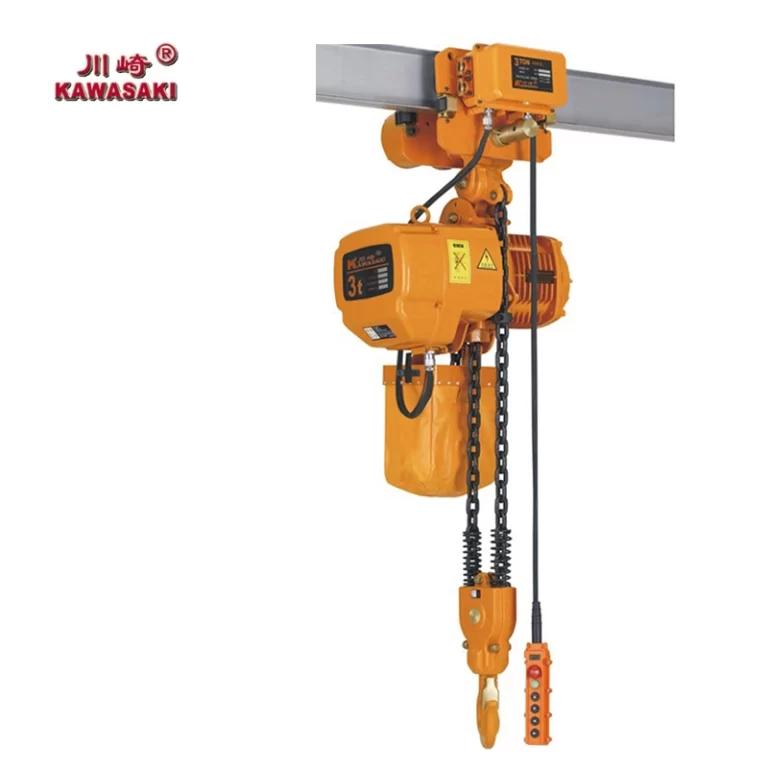Pre-Operation Safety Checks
Before operating an electric chain hoist, thorough inspection and preparation are essential to ensure safe working conditions. These preliminary checks help identify potential hazards before they can cause accidents.
Daily Inspection Checklist
- Visual Inspection:Examine the hoist for any visible damage, cracks, or deformities in the housing, hooks, and chain.
- Hook Inspection:Check hooks for twisting, cracks, or excessive wear. Ensure safety latches function properly.
- Chain Examination:Inspect the load chain for stretching, wear, twists, or damaged links.
- Electrical Components:Verify that control pendants, cords, and connections are in good condition without exposed wires.
- Limit Switches:Test both upper and lower limit switches to ensure they stop the hoist at the correct positions.
- Brake System:Verify that the brake holds the load securely without slipping.
- Load Path Clearance:Ensure the lifting path is clear of obstructions and personnel.
Important Note
If any defects are found during inspection, immediately tag the hoist “OUT OF SERVICE” and report the issue to a supervisor. Never operate a hoist with known defects or safety concerns.
Critical Safety Rules During Operation
Essential DOs for Safe Operation
- Verify Load Weight:Always confirm the load weight does not exceed the hoist’s rated capacity.
- Center the Load:Ensure the load is properly balanced and centered under the hook.
- Lift Vertically:Lift loads straight up without side pulling or jerking motions.
- Use Proper Rigging:Employ appropriate slings, shackles, and attachments rated for the load.
- Maintain Clear View:Keep the load in sight during lifting and moving operations.
- Lift Smoothly:Operate controls smoothly to prevent load swinging and sudden stresses.
- Test Lift:Perform a test lift a few inches off the ground to verify stability before full lifting.
- Keep Hands Clear:Never place hands on the chain or near pinch points during operation.
Critical DON’Ts for Accident Prevention
- Never Exceed Capacity:Do not lift loads heavier than the hoist’s rated capacity.
- No Riding:Never allow personnel to ride on the hoist or load.
- Avoid Side Pulling:Do not use the hoist for side pulls or dragging loads horizontally.
- No Sudden Movements:Avoid jerky operations that can cause load swinging or shock loading.
- Don’t Leave Suspended Loads:Never leave loads suspended unattended.
- Avoid Twisted Chains:Do not operate with twisted, knotted, or damaged chains.
- No Unauthorized Use:Do not allow untrained personnel to operate the hoist.
- Don’t Use as Personnel Lift:Never use electric chain hoists for lifting people.
DANGER: High-Risk Situations
Extra caution is required in these high-risk scenarios:
- Lifting loads near or over personnel
- Working in hazardous environments (explosive, corrosive, or wet conditions)
- Lifting loads with sharp edges that could damage slings or chains
- Operations in high-temperature areas that could affect hoist components
Personal Protective Equipment (PPE)
Proper personal protective equipment is essential for operators and personnel in the work area:
| PPE Item | Purpose | Standards |
| Safety Helmet | Protection from falling objects | ANSI Z89.1, CSA Z94.1 |
| Steel-Toed Boots | Foot protection from heavy objects | ASTM F2413, CSA Z195 |
| Safety Glasses | Eye protection from debris | ANSI Z87.1, CSA Z94.3 |
| Gloves | Hand protection during rigging | Task-specific cut/impact resistant |
| High-Visibility Vest | Enhanced visibility to other workers | ANSI/ISEA 107, CSA Z96 |
Work Area Safety Considerations
Properly defined work zones are essential for preventing accidents and ensuring organized operations. These zones establish clear boundaries that separate hoist operations from other work activities, reducing the risk of personnel entering hazardous areas.
Zone Classification System
Implementing a color-coded zone system helps personnel quickly identify different areas and their associated risks:
| Zone Type | Color Code | Purpose | Access Restrictions |
| Primary Operation Zone | Red/White Stripes | Immediate hoist operation area | Authorized operators only during active lifting |
| Secondary Buffer Zone | Yellow/Black Stripes | Area around primary zone for staging and approach | Authorized personnel with heightened awareness |
| Observation Zone | Solid Yellow | Designated safe viewing areas | All personnel with proper PPE |
| Equipment Storage Zone | Solid Green | Storage for rigging equipment and accessories | Authorized personnel only |
Physical Barriers and Signage
Effective physical barriers and clear signage are critical components of work area safety:
- Barrier Systems:Install physical barriers such as guardrails, chains, or fencing around the primary operation zone to prevent accidental entry.
- Warning Signs:Place highly visible warning signs at all access points to the work area, indicating potential hazards and required PPE.
- Capacity Charts:Display the hoist’s rated capacity chart in a prominent location near the control station.
- Operating Instructions:Provide clear operating instructions and emergency procedures in the work area.
- Lighting and Visibility:Ensure adequate lighting for both daytime and nighttime operations, with additional task lighting for precise positioning.
Environmental conditions significantly impact hoist safety and performance. Understanding and mitigating these factors is essential for safe operations.
Floor and Foundation Considerations
The condition and capacity of floors and supporting structures are critical safety factors:
- Load-Bearing Capacity:Verify that floors and support structures can withstand the combined weight of the hoist, load, and any dynamic forces.
- Surface Conditions:Maintain clean, level, and slip-resistant surfaces in the work area to prevent trips and falls.
- Drainage and Spill Control:Implement proper drainage and spill containment measures, especially in areas where fluids might accumulate.
- Anchoring Systems:Ensure proper installation and regular inspection of hoist anchoring systems and structural supports.
- Clearance Maintenance:Keep floors clear of debris, tools, and unnecessary equipment that could create hazards.
When multiple hoists operate in proximity, additional safety measures are required to prevent interference and accidents.
Coordination Requirements
Operations involving multiple hoists require:
- Designated coordinator with authority over all lifting operations
- Clear communication protocols (radios, hand signals, light systems)
- Established right-of-way procedures for intersecting load paths
- Additional buffer zones between adjacent operation areas
- Emergency stop coordination for all hoists in the area
Regular inspection and maintenance of the work area ensure ongoing safety compliance.
Daily Inspection Checklist
- Verify all zone markings are visible and undamaged
- Check that barriers and warning signs are properly positioned
- Confirm adequate lighting throughout the work area
- Inspect floors for spills, debris, or damage
- Verify clear access to emergency equipment and exits
- Check that fire extinguishers are accessible and charged
- Confirm first aid supplies are available and stocked
Proper emergency planning specific to the work area enhances response effectiveness during incidents.
Emergency Equipment Placement
Strategic placement of emergency equipment ensures rapid response:
- Emergency stop stations at all primary access points
- First aid kits within 30 seconds travel time from any work position
- Fire extinguishers appropriate for potential fire types
- Emergency communication devices (alarms, phones, radios)
- Spill containment and cleanup materials for hazardous substances

Electrical Safety Procedures
Electric chain hoists present specific electrical hazards that require special precautions:
Electrical Safety Guidelines
- Inspect power cords and control pendants for damage before each use
- Ensure proper grounding of the hoist and power supply
- Use appropriate circuit protection and disconnect means
- Keep electrical components away from water and moisture
- Report any electrical issues immediately – do not attempt repairs unless qualified
Emergency Procedures
Emergency Response Plan
All operators must be familiar with emergency procedures:
Power Failure
- If power fails during operation, keep clear of the suspended load
- Secure the area to prevent access until power is restored
- Some hoists have manual lowering features – use only if trained
Malfunction During Operation
- Immediately stop operation if unusual noises, smells, or movements occur
- Use emergency stop button if available
- Secure the area and report the issue to maintenance personnel
Load Dropping or Slipping
- Evacuate the area immediately if a load begins to fall or slip
- Never attempt to catch a falling load
- Report the incident to supervisors for investigation
Training and Competency Requirements
Proper training is fundamental to safe hoist operation:
| Training Component | Content | Frequency |
| Initial Training | Hoist operation, safety procedures, emergency response | Before first operation |
| Refresher Training | Reinforcement of safety procedures, updates to protocols | Annually or as needed |
| Specific Equipment Training | Operation of particular hoist models and their unique features | When assigned to new equipment |
| Rigging Training | Proper load attachment, sling angles, weight estimation | Before rigging responsibilities |
Maintenance and Inspection Protocols
Regular maintenance is essential for ongoing safe operation:
Scheduled Inspections
- Daily:Visual inspection by operator before use
- Monthly:Functional tests and detailed inspection by qualified personnel
- Annual:Comprehensive inspection and maintenance by certified technicians
- Documentation:Maintain records of all inspections, maintenance, and repairs
Safety Culture
Beyond specific procedures, developing a strong safety culture is essential. Encourage all personnel to:
- Speak up about safety concerns without fear of reprisal
- Participate in safety meetings and training sessions
- Look out for each other’s safety
- Follow procedures even when no one is watching
- Continuously look for ways to improve safety
Conclusion
Electric chain hoists are invaluable tools in industrial settings, but they demand respect and proper handling. By following these safety guidelines, conducting thorough inspections, using appropriate PPE, and maintaining a strong safety culture, organizations can significantly reduce the risk of accidents and injuries. Remember that no production schedule or deadline is worth compromising safety procedures. When in doubt, always prioritize safety over speed or convenience.
Safety Reference Guide | Electric Chain Hoist Operation
© 2023 Industrial Equipment Solutions. All rights reserved.


